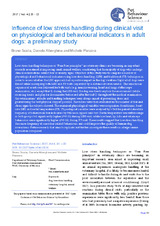Influence of low stress handling during clinical visit on physiological and behavioural indicators in adult dogs: a preliminary study
Autor
Scalia, Bruno
Alberghina, Daniela
Panzera, Michele
Editor
Universidad de Córdoba, Departamento de Medicina y Cirugía AnimalFecha
2017Materia
DogsLow-stress handling
Veterinary hospital
Animal welfare
METS:
Mostrar el registro METSPREMIS:
Mostrar el registro PREMISMetadatos
Mostrar el registro completo del ítemResumen
Low stress handling techniques or “Fear Free principles” in veterinary clinics are becoming an important research area aimed at improving small animal welfare, considering that the majority of dogs who undergo clinical examinations exhibit fear or anxiety signs. Objective of this study was to compare a number of physiological and behavioural indicators using low stress handling (LSH) and traditional (TT) techniques in order to assess whether the LSH approach had a positive impact on the dog’s welfare. Eight adult dogs were filmed while undergoing both LSH and TT visits (separated by a distance of seven weeks). The same usual sequence of events was followed for both visits (e. g. muzzle wearing, heart and lungs stethoscope examination, etc.) except that 1) during the LSH visit, the dog was free to explore the environment (while receiving treats) and play for five minutes before and after the visit 2) throughout the medical examination the veterinarians’ attitude and handling techniques were always aimed at preventing stress and guaranteeing the best physical support possible. The videos were then evaluated for the number of fear and stress signs the subjects showed. The examined physiological variables were respiration (breath/min), heart rate (HR) and rectal temperature (RT). Physiological variables were analysed by t-Test for paired data while frequency of behavioural fear indicators by Wilcoxon signed-rank test. Rectal temperature was within range in both groups but significantly higher (P<0.05) during LSH visit, while low head, lip licks and whale eye behaviours were significantly higher (P<0.05) during TT visit. These results suggest that low stress handling decreases frequency of some fear-related behaviours and could improve the quality of human-dog interactions. Future research that aims to replicate and further investigate these results in a large canine population is required.

